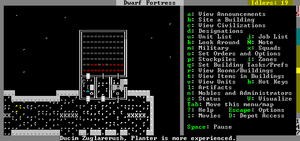- v50 information can now be added to pages in the main namespace. v0.47 information can still be found in the DF2014 namespace. See here for more details on the new versioning policy.
- Use this page to report any issues related to the migration.
40d:Bauxite
| ||||||||||||||||||||||||||||||||||||
| Uses | ||||||||||||||||||||||||||||||||||||
|---|---|---|---|---|---|---|---|---|---|---|---|---|---|---|---|---|---|---|---|---|---|---|---|---|---|---|---|---|---|---|---|---|---|---|---|---|
| Location | ||||||||||||||||||||||||||||||||||||
|
| ||||||||||||||||||||||||||||||||||||
| Properties | ||||||||||||||||||||||||||||||||||||
| ||||||||||||||||||||||||||||||||||||
| Contains | ||||||||||||||||||||||||||||||||||||
|
| ||||||||||||||||||||||||||||||||||||
| This article is about an older version of DF. |
Bauxite is the only stone, apart from Raw adamantine, that is suitable for the construction of mechanisms to be used in floodgates which will come into contact with magma. Unfortunately bauxite can be found only in sedimentary layers, which are rare around volcanoes (but not near magma pipes in general). However, you can usually trade for Bauxite stones with the Dwarven caravans (this is determined by availability in your home civilization). They're not expensive, and you should get enough to make any number of bauxite mechanisms you need. You can also plan ahead and buy some before embarking, so long as the civilization that you embark from has bauxite.
If in limited supply on your map (and you are going to be playing with magma), be sure to keep your mason and various craftsdwarves away from what bauxite you do have until you can turn it into mechanisms; best forbid them until you are ready.
Bauxite is the only stone that contains rubies and sapphires, both found as small clusters.
While Bauxite is an aluminum ore in Real Life, the technology to extract aluminum from it does not exist in the game setting.
Bauxite Management
If you are on a map with very limited or no naturally occurring bauxite, getting your hands on it can be difficult. Although likely that one of the civilizations you have access to will have the mineral for sale, they can only bring so much of it. Wasting bauxite is a terrible crime, so it is a good idea to come up with a way to minimize misuse.
To the right is an example of how to control your bauxite. The interior of the room to the north is a stockpile with only bauxite designated for storage. Below it are three slots for workshops (only two are used in the picture). Draft a mason/mechanic into a one-man squad and station him inside the bauxite stockpile, then lock the exterior doors and open the interior ones. When he has completed constructing your bauxite equipment, make sure he is outside of the stockpile and lock the interior and unlock the exterior. This makes it virtually impossible for any slip-ups to happen, preventing any bauxite from being wasted.
Alternately, if you prefer not to use military drafting (which can cause an unhappy thought), you can place a lever in the outer room that is linked to the external door, and then use workshop profile for that lever to restrict it to only the target mason. Issuing a "pull lever" will cause that mason to respond, automatically locking himself into the controlled area, ready to go.
Another possible method would be to simply have a mason/mechanic who is entirely devoted to the production of bauxite objects. This would involve at least two layers: One where this dwarf works, one where the bauxite items are received. The room would have the bauxite stocks, food, booze, a bed, table and chair, and a small hole in the floor for dumping, which is accessible by the rest of the fort. Food can be put in either through an airlock style design or by dumping it into a quantum stockpile. After making the items in a completely sealed off room, have them set to be dumped down the receiving hole, then unforbid them so that the other dwarves will gather it. If you want to keep him occupied, you can always boost his stats by having him operate a pump or similar. This way you can have high quality mechanisms and furniture made quickly when you need them. Just make sure to check up on his food supplies occasionally.
an ore of aluminum, but through a too-advanced process, in-game as the source of the corundum gemstones (ruby and sapphire)
bauxite melts around 2000C, so it's not practical to smelt it for aluminum (magma only goes up to 1300-1400)
[MATGLOSS_STONE:BAUXITE]
[NAME:bauxite][COLOR:4:7:0][TILE:'+']
[ENVIRONMENT:SEDIMENTARY:CLUSTER:100]
[MELTING_POINT:13600]
[BOILING_POINT:15000] |
| Sedimentary | |||||
|---|---|---|---|---|---|
| Igneous |
| ||||
| Metamorphic | |||||
| Ore | |||||
| Economic | |||||
| Other |
Alabaster · Alunite · Anhydrite · Bauxite · Borax · Brimstone · Chromite · Cinnabar · Cobaltite · Cryolite · Graphite · Gypsum · Hornblende · Ilmenite · Jet · Kaolinite · Kimberlite · Marcasite · Mica · Microcline · Olivine · Orpiment · Orthoclase · Periclase · Petrified wood · Pitchblende · Puddingstone · Pyrolusite · Realgar · Rutile · Saltpeter · Satinspar · Selenite · Serpentine · Stibnite · Sylvite · Talc | ||||
